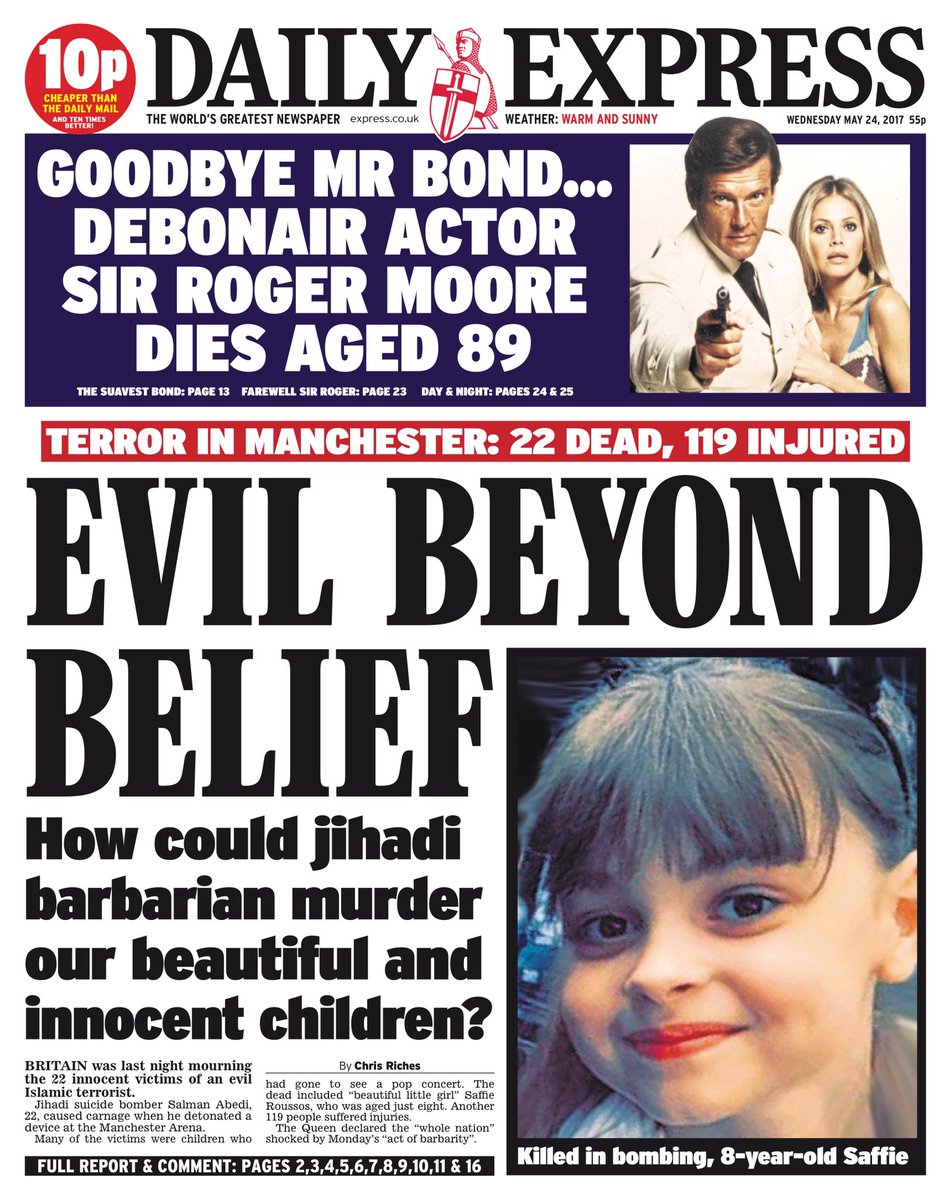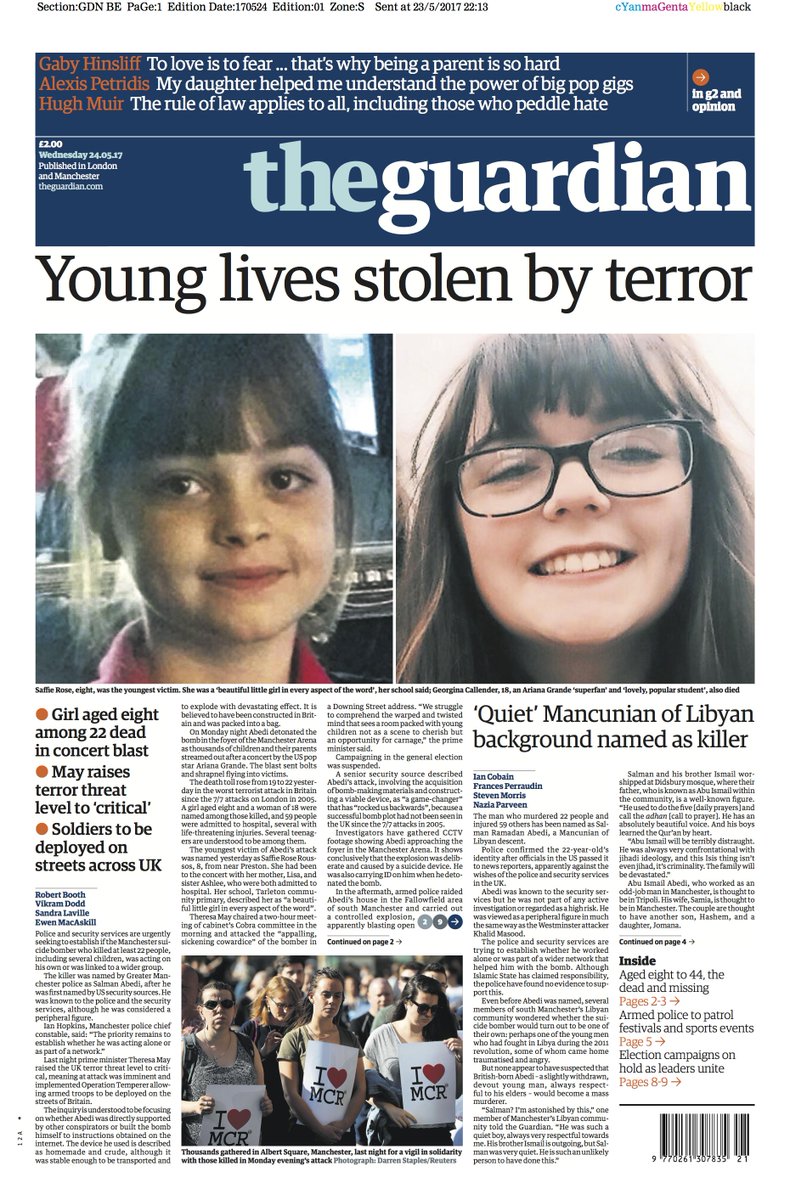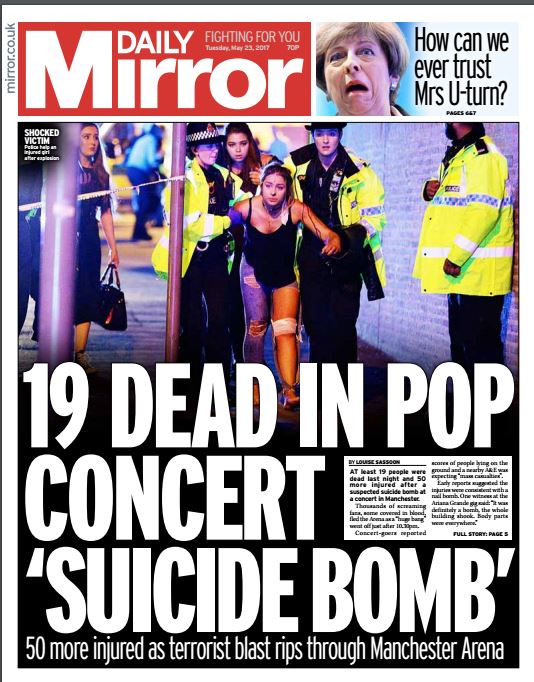A Look at the Newspaper Coverage of the Manchester Terrorist Attack - Rhys Wallett
When looking at how the popular British newspaper companies portrayed the harrowing tragedy which happened in Manchester on May 22nd, 2017, we can see as to how different newspapers have portrayed this, and how their political view and their place on the right wing / left wing spectrum has influenced this to see how powerful news companies control how we would view this tragic loss.
If we are to start with the 'Daily Express', who are well known as a conservative, right-wing newspaper who have more traditional ideas, we can see how their choice of format to tell the tragedy has been created in a way in which themes of racial discrimination can be shown, which is hugely regressive for our society. Let's start with the subtitle on the front page, where the rhetorical question "How could jihadi barbarian murder our beautiful and innocent children?". This is a hugely regressive and negative statement, rife with racism and discrimination, such as how for starters, the Daily Express has chosen to call the people responsible for the attack "jihadi barbarian"'s, which is a hugely offensive statement for those of Muslim faith and are not part of the extremist Muslim sub-community. In addition, the decision to refer to children like Saffie as "our beautiful and innocent children?"can also be considered offensive as "our" is referring to British children, therefore it would not be unreasonable to assume that the Daily Express is attempting to say how British youth are way more beautiful and precious than those of different faiths, plus the fact that the secondary image shows a Caucasian girl, this can have subtle reference to how the Caucasian race may be the purest of races, an extremely horrific and barbaric perspective. This is extremely plausible however as the Daily Express newspaper has traditional, conservative values which include a dichotomy between the races. On a side note, the fact that the 3 people found on the front cover are of the Caucasian race, which can show anti-diverse ideals and how the Caucasian Bond is referred to with respect with "Goodbye Mr. Bond", while the only reference to other culture is "barbarian".
Furthermore, we can also prove they have attempted to attack other races and ethnicities when telling the story with the tertiary title "... evil Islamic terrorist." The unnecessary inclusion of "evil Islamic" shows racist motives as it described the entire Islam community in a Machiavellian manner, which is completely inaccurate and false as it was a sub-community who have Islam related faith. Therefore, a primary audience (who would be traditional, middle-aged, white, straight men) would form negative opinions of those of Islamic faith which could potentially grow into a prejudice of all those of different culture.
However, when we look at how 'The Guardian' has told and portrayed the same story, we can see a strong difference in how it has been formatted and shown, along with the similarities and differences of the portrayal in the 'Daily Express'. As 'The Guardian' is a more open/ left-wing newspaper, we can see how any potential racism or degrading of communities has been drastically reduced and instead focuses solely on the story. We can use the masthead "Young lives stolen by terror" as evidence as the masthead is simple and straight to the point, and does not include degrading insults like the 'Daily Express' subtitle. This allows the judgment and conservative ideal to be absent as it raises awareness as to how the vast majority of Islamic faith does not agree or share ideas with ISIS and reduces any potential racism to be found in the advert. A critic, however, could still attempt to prove it isn't entirely ethnicity equal as all the people found on the front cover are Caucasian women, so †hose of other cultures are of less importance in the story, thus while the sexism has been avoided, the racism hasn't necessarily.
Plus, similarly to the 'Daily Express', 'The Guardian' has also used the primary image of a close-up of 8-year-old Saffie, who perished in the terrible tragedy, as their main selling point. This has been intentional because as humans, we have an innate response to care for children, thus seeing a child die, the audience's sympathy and glumness increase tenfold as it plays on our heartstrings as an audience, and so we are prompted to read and feel more tragic about the event.
Lastly, let's look at how the 'Daily Mirror' has portrayed this story as they are one of the most open, reformer, left-wing popular newspapers in England. Unlike the 'Daily Express' and 'The Guardian', the 'Daily Mirror' have not used Saffie as their primary case study and selling point, instead, the CVI shows a long shot of 2 female police officers aiding a wounded teenage girl. This still allows the wounded youth selling ideal to arise, but it allows a younger audience to connect more personally with this story, therefore allowing their target audience to broaden. Plus, as the CVI shows a coloured male police officer, we can sue this as evidence that the 'Daily Mirror' has been more multicultural in their presentation of the attack.
And as we read the story, there is no insulting of the race of the suicide bomber, nor any racist or discriminatory remarks at all. Much like 'The Guardian' their text such as their masthead "19 dead in pop concert 'suicide bomb' has ignored any degrading insults and name calling found in the 'Daily Express', thus fulfilling their tagline of "Fighting for you" as they have proven to create an equal look at the tragedy, and are more factual and less idealised.



No comments:
Post a Comment